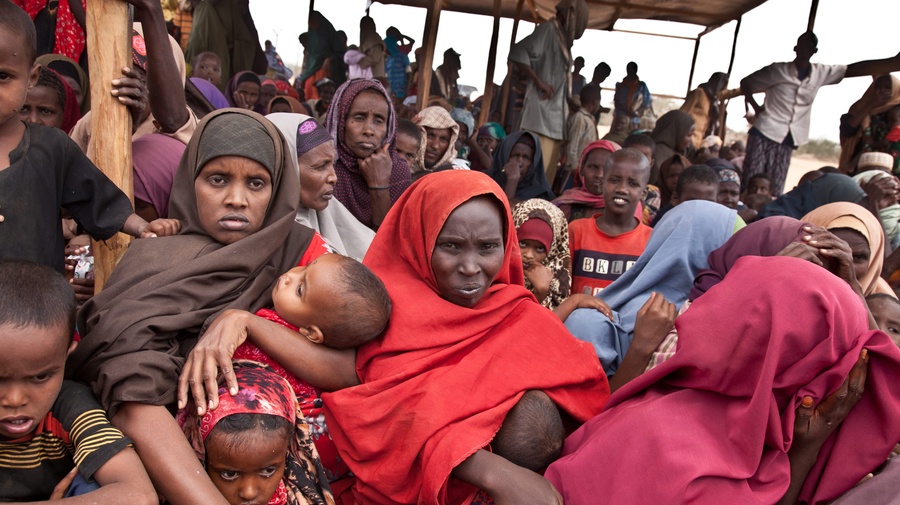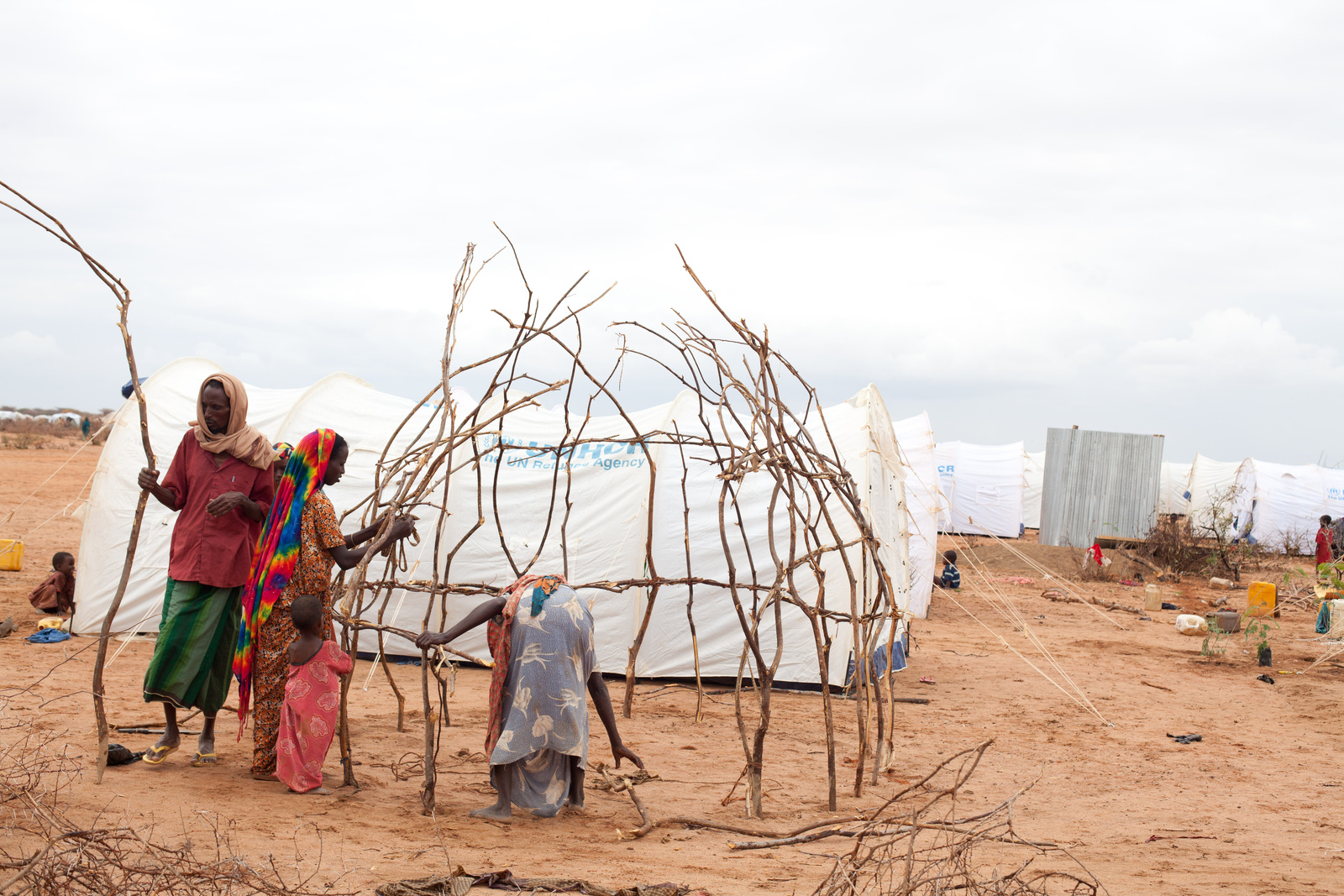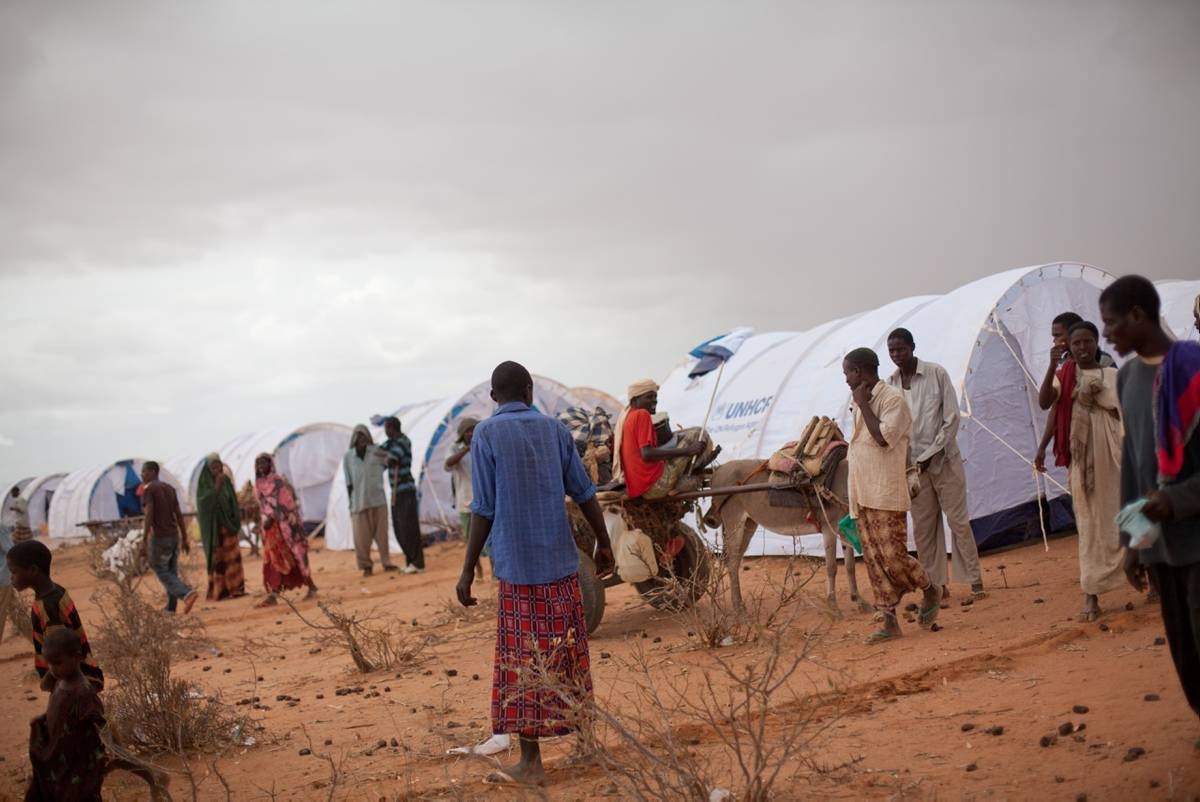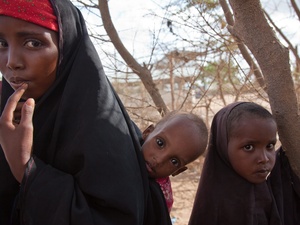Drought and displacement in Somalia: Fleeing from dust and starvation
Drought and displacement in Somalia: Fleeing from dust and starvation

It's early in the morning and recently arrived refugees wait in the shade outside the Dagahaley reception centre.
DAGAHALEY REFUGEE CAMP, Kenya, August 2 (UNHCR) - Abdulahi Haji Hassan gazes at the exhausted and confused faces of his family and contemplates the toll that drought and famine has taken on their lives. His two-year-old son, Madey, leans listlessly against his mother's breast.
Fama, Abdulahi's four-year-old daughter, is covered in dust from the 27-day trek through the howling desert from their home near Baidoa in southern Somalia to the Kenyan border. Her tears form pathways along her dust-covered face. His wife Haway's lips tighten at the thought that it could be years before she sees home. But Abdulahi has made a life-changing calculation. "My home is nothing but dust and starvation," he says. "I cannot go back there."
Walking towards asylum was not a matter of choice. The family livelihood depended on herding animals. Abdulahi's 70 goats and 30 cows fell ill and died one-by-one as the worst drought in memory denied the animals water and feed. The livestock were in many ways considered to be part of his extended family and their loss was catastrophic.
When the last cow died, everyone knew that the children would be next. Abdulahi's mother told him to leave the village. "I want your children not to die of hunger," she said. "You go anywhere you can to get help and I will pray for you to get there safely."
The Hassan family is among the 1,300 refugees who arrive daily from Somalia to the camps around Dadaab in north-east Kenya, including Dagahaley. The ability of UNHCR to accommodate the new arrivals people improves each day, but running a refugee city of 400,000 is daunting. UNHCR and the government of Kenya have taken great strides forward. But more resources are needed to protect the vulnerable, provide shelter and see to health needs.
The Journey
For those fleeing Somalia, the first and perhaps most painful undertaking is the journey itself. The Hassan family organized their expedition with seven other families. They took with them all they had left in the world; a donkey cart made from a discarded car axle, a bag of ground maize and a large plastic container of water.
They rested by day and walked by night. After a week, time folded in on itself. "All the nights you travel are the same. There is no good night and no bad night. There is only night," Abdulahi says. "You think about the situation of your children, which one you are worried about. I worried about the smallest of course." The children ate small servings of maize and water while the parents largely went without.
When he wasn't thinking about his children, Abdulahi's thoughts turned to his mother. This was the first time he had spent more than a day away from her. Even atop a donkey cart, she was too old and frail to survive the journey. "She told me that she would pray for me. She told me that I would reach my destination," Abdulahi says.
Though she was staying with another of his brothers, thoughts of her swirled in Hassan's mind: "Would she be missing anything to eat? Would she be sick? Would she die before I could come home again? I didn't cry but I was so much worried."
As they approached the Kenyan border, the group encountered bandits. Brandishing AK-47 assault rifles, the robbers searched through every sack. "When they found nothing, they started beating us with the back of their guns," Abdulahi says. One of his brothers sustained two broken ribs.
The Reception
It's seven in the morning and recently arrived refugees congregate in clutches in front of the entrance to the Dagahaley camp reception centre. An old woman coughs into the morning air, complaining of illness. Mariam Mohamud, 30, has given birth to a baby girl during the night. Mariam wraps her child in a red cloth and holds her between her arms.
Health workers from UNHCR partner Médecins Sans Frontières spot mother and child and bring them to the reception centre clinic. Hassan Abdi normally prides himself on maintaining an even-keeled professionalism, but now the emotions are apparent on the doctor's face.
He reaches for the tiny child and holds her delicately in his hands. After a few minutes, he breathes a sigh of relief. "This baby is just fine," he says. Her mother is exhausted and has yet to name the infant. They settle on Mariam. Mother and daughter are placed in an ambulance bound for the local hospital, along with severely malnourished Muhammed Abdulahi. At two years of age Abdulahi weighs just five kilogrammes - a bit more than most newly born babies.
Meanwhile staff members from the Kenyan government, UNHCR and its partners process the newly arrived, provide them with food and non-food items. Mothers, fathers and children pass through a line where fingerprints are taken and vital information fed into UNHCR's computer database. The process is critical to tracking the flow of asylum-seekers and ensuring that all who need assistance get it.
In line, families sit together quietly. It is a relatively peaceful moment in an existence filled with desperation. It takes about 90 minutes for UNHCR and its partner to register a refugee, provide an initial medical assessment, give them food and other items and screen for those who are most vulnerable. "Don't let the calmness fool you," says Roger Naylor, a UNHCR field officer in Dagahaley. "The reason why it's calm is because we are extremely well organized and these refugees are exhausted."
David Owalo Magolo, 48, has worked at the refugee camps around Dadaab since 1996. He has never seen an emergency as critical as the one he is now facing. "The women and the children have suffered tremendously. When they are walking [towards Kenya] they often have to take several children with them. They walk 500 metres with one child, put him down then go back to pick up the next."
The faces of refugees are branded into David's mind and he believes it is only a matter of time until they make their way into his dreams at night. He works hard to focus on the other moments in this crisis - the ones that give him a sense of pride and of hope.
"The best part of the day is when you see that someone has been received into the system," he says. "They are given food and clothing . . . We have screened their health, they have food, non-food items like cooking pots and pans. They have something to begin with."
Members of the local community, many of whom have lived in Dadaab for nearly 20 years, have also sought to help. "When we saw the refugees arriving, members of the religious and youth community inside the camps decided that they needed to help," says 38-year-old refugee, Mahat Ahmed. "We told people, if you have two shirts, give one. If you have two pairs of shoes give one pair."
The word, of how refugees gave what little they had, spread to other parts of the Somali diaspora. Soon Somali businessmen and others, from Nairobi to North America, donated to the cause. Each day, truckloads of milk, biscuits and clothes arrive at the refugee camps and are distributed to families in plastic bags.
These refugee humanitarians see their effort not as a single act, but as a signal for all who want to help. "It is a matter of faith," says refugee Barre Osman, 24, who distributes milk and biscuits. "Human hearts are connected and our hearts are as one. We all come from Adam and Eve and we are all brothers and sisters."
By Greg Beals in Dagahaley Refugee Camp, Kenya





















